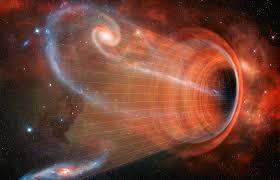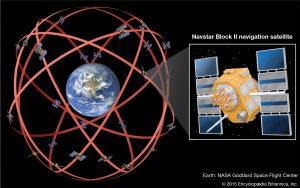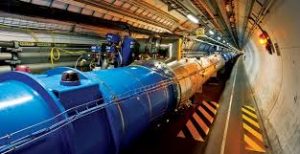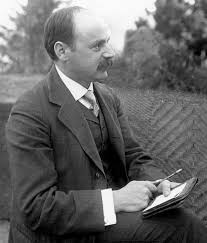We have already built time machines
We said in the previous post (Travelling through time (I)) that, according to Hawking, there are at least three possible ways to travel through time:
1. Getting close to a black hole

Just as in a riverbed water flows in different places with different velocities, it is to be expected that, in any space-time where the distribution of mass generates variable curvature, time will flow with different velocities in different places: sometimes faster, sometimes slower. The General Theory of Relativity predicts this phenomenon. Specifically, near a large accumulation of mass, time should slow down, like water in the shallowest part of a river. Naturally, this opens up the possibility of travelling into the future.
We know one proof that this prediction is correct: the Global Positioning System, commonly called GPS. It is well known that, in order that the results provided by this system be accurate, the time measurements taken by the satellites must be corrected by approximately \(3 \times 10^{-10}\) seconds every day. Logical: time runs faster in space than on Earth, precisely because of Earth’s enormous mass.

The most massive object in the Milky Way has been located in the centre, 26,000 light-years away from us. It is thought to be a large black hole caused by the gravitational collision of a huge number of stars. Approaching it has the effect of slowing down time. In particular, a spacecraft capable of orbiting is a time machine in which navigators age much more slowly than on Earth and therefore “travel to the future”.
2. Travelling really fast
Trying to get close to a black hole is impractical. It is a really long journey and, in fact, it is not clear it is actually worth it. The best hope we have of being able to build a time machine is based on consequences of the Special Theory of Relativity.

The idea is to travel at breakneck speed. Very fast indeed. Travelling at speeds close to the speed of light transports us into the future. Indeed, the dimensions of space-time measured by an observer in a vehicle travelling at high speed relative to an observer on Earth can be calculated from those measured by the latter using the Lorentz transformation. In particular, as explained below, time passes slowly again, just as it would do near a black hole.
Consider a spacecraft orbiting the Earth for 100 years at a speed close to the speed of light. For the occupants, much less time will have passed, on the order of a week. Again, a vehicle capable of this feat is a time machine.

An experiment to confirm this phenomenon may seem unrealistic, but it is not. We have the Large Hadron Collider at CERN in Geneva, the world’s largest particle accelerator. In a circular tunnel more than 27 km long, atomic particles can be made to travel at enormous speed, close to the speed of light (of the order of 99.9%). In particular, it is observed that pi-mesons, which ordinarily disintegrate in an extremely short time, “endure” a time period approximately 30 times longer. Once again, we see that these particles have “travelled to the future”.
3. By means of a wormhole
In this way it would be possible, at least theoretically, to travel back in time. Unfortunately, such travel could only take place at subatomic scales, which is irrelevant on a practical level. But, since the description of wormholes must be done in detail, we will leave this possibility for a future post.
For the more demanding reader
The Special Theory of Relativity is based on two simple axioms: (a) the laws of physics must be invariant for two observers moving at constant speeds relative to each other and (b) the speed of light in vacuum is constant for any observer. As a consequence, the concepts of absolute space and time and simultaneity are lost.

Thus, in the context of this theory, let us imagine two observers \(S\) and \(S’\) whose positions coincide at initial time, to which we assign two reference frames, so that the events are identified by \(S\) (resp. \(S’\)) by the coordinates \((t,x_1,x_2,x_3)\) (resp. the coordinates \((t’,x’_1,x’_2,x’_3)\)).
Suppose that (for example) \(S’\) moves with respect to \(S\) in the direction of the \(x_1\)-axis with constant velocity \(v\). Then the values of \((t’,x’_1,x’_2,x’_3)\) are obtained from the values of \((t,x_1,x_2,x_3)\) via the Lorentz transformation:
$$
t’ = \gamma(t – vx_1/c^2), \ \ x’_1 = \gamma (x_1 – vt), \ \ x’_2 = x_2, \ \ x’_3 = x_3,
$$
where \(\gamma = (1 – v^2/c^2)^{-1/2}\) and \(c\) is the speed of light in vacuum.
An immediate consequence of the Lorentz transformation is the invariance of the expression
$$
(\Delta s)^2 := c^2(\Delta t)^2 – \left( (\Delta x_1)^2 + (\Delta x_2)^2 + (\Delta x_3)^2 \right)
$$
(i.e., that \((\Delta s)^2 = (\Delta s’)^2\) for any two observers \(S\) and \(S’\) under the above conditions; here, \(\Delta z\) is, by definition, the change of the coordinate \(z\) when passing from one event to the other). Two other consequences are the phenomena of space contraction
$$
\Delta x’_1 = \gamma^{-1} \Delta x_1 \ \ \hbox{ for events that verify $\Delta t’ = 0$}
$$
and time dilatation
$$
\Delta t’ = \gamma \Delta t \ \ \hbox{ for events that verify $\Delta x_i = 0$.}
$$
In particular, the latter formula shows that, if we move at high speed, we travel into the future.
In the Theory of General Relativity, axiom (a) above is generalised so that it remains true for any two observers, including those moving with non-constant relative velocities. The relation between the curvature of space-time and the energy and momentum associated with the mass distribution is given by a complicated system of non-linear PDEs whose unknowns are the \(g_{\mu\nu}\) (\(10\) functions of the variables \(x_0:=ct\), \(x_1\), \(x_2\) and \(x_3\)):
$$
R_{\mu\nu} – {1\over2} R g_{\mu\nu} = \kappa T_{\mu\nu}.
$$
Here, \(R = g^{\mu\nu} R_{\mu\nu}\) is the scalar curvature, the \(R_{\mu\nu}\), \(g_{\mu\nu}\) and \(T_{\mu\nu}\) are, respectively, the components of the Ricci tensor, the metric tensor and the energy-momentum tensor and \(\kappa = 8 \pi G/c^4\), where \(G\) is the gravitational constant and, again, \(c\) is the speed of light in the vacuum. These are the Einstein’s equations.
The components of the Ricci tensor are given by
$$
R_{\mu\nu} = {R^\rho}_{\mu\rho\nu} := \partial_\rho\Gamma^\rho_{\nu\mu}
– \partial_\nu\Gamma^\rho_{\rho\mu}
+ \Gamma^\rho_{\rho\lambda}\Gamma^\lambda_{\nu\mu}
– \Gamma^\rho_{\nu\lambda}\Gamma^\lambda_{\rho\mu} ,
$$
where \({R^\rho}_{\mu\lambda\nu}\) are the curvature tensor components and \(\Gamma^\rho_{\mu\nu}\) are the Christoffel symbols, defined by the relations
$$
D_\rho g_{\mu\nu} := \partial_\rho g_{\mu\nu} – g_{\lambda\nu}\Gamma^\lambda_{\mu\rho} – g_{\mu\lambda}\Gamma^\lambda_{\nu\rho}=0 .
$$
The \(T_{\mu,\nu}\) (components of the energy-momentum tensor) determine the density and flux of energy and linear momentum in space-time. They play the role of “source” data in Einstein’s equations, analogous to the way mass density plays the role of source in Newtonian mechanics.
Einstein was not the only scientist interested in formulating equations describing the geometry of space-time in the presence of mass distribution, taking into account the corresponding gravitational effects. David Hilbert and Marcel Grossman should be mentioned here (at least). In fact, their authorship is not entirely uncontroversial (see the posts Einstein and Hilbert 1 and 2 in this Blog). Influenced by the idea that the Universe was static, Einstein introduced into the field equations an additional constant, the “cosmological constant” \(\Lambda\), to counteract the gravitational effects. The resulting system looked like this:
$$
R_{\mu\nu} – {1\over2} R g_{\mu\nu} + \Lambda g_{\mu\nu} = \kappa T_{\mu\nu}.
$$
Later, after Hubble’s discoveries, it was learned that the Universe is expanding, and the view prevailed that the constant was inappropriate. Indeed, Einstein himself went so far as to say that “the cosmological constant had been the biggest blunder of his life”. However, recent discoveries since 1998 have shown that the expansion of the Universe is accelerating, which again opens up the possibility of the presence of \(\Lambda\) in the field equations.
A Schwarzschild black hole is any solution of the Einstein equations of the form
$$
g \!=\! -c^2 \left(1\!-\!\frac{2GM}{c^2 r} \right) \mathrm{d}t \!\otimes\! \mathrm{d}t \!+\! \left(1\!-\!\frac{2GM}{c^2 r}\right)^{-1}\mathrm{d}r \!\otimes\! \mathrm{d}r \!+\! r^2 \left(\mathrm{d}\theta \!\otimes\! \mathrm{d}\theta \!+\! (\sin^2\theta) \,\mathrm{d}\phi \!\otimes\! \mathrm{d}\phi \right)
$$
(written in spherical coordinates), where \(M\) is a positive constant (the mass of the hole). The spherical surface \(r = 2GM/c^2\), called the event horizon, is interpreted to determine a region of space-time of maximal attraction, from which not even light can escape. This fully justifies that this metric tensor is called a black hole. Schwarzschild’s life alone deserves a full entry in this Blog. Although he died relatively young, at the age of 43, he developed an important scientific activity in several fields of physics, including contributions in optics and astronomy.
In view of the above, it is clear that the resolution (theoretical and numerical) of Einstein’s equations is very difficult. For example, in the context of the binary black hole problem (two black holes orbiting each other), significant results have only been achieved in the last 10 years or so. For an overview, see the presentations of Lee Lindblom in [9].
Learn more
-
A. Einstein, On the Electrodynamics of Moving Bodies (translation from the original), Annalen der Physik. 17: 891, 1905.
-
A. Einstein, Lectures at the University of Berlin, Sitzungsberichte der Preussischen Akademie der Wissenschaften zu Berlin, p. 844-847, 778-786, 799-801, 831-839, Nov. 1915.
-
K. Schwarzschild, On the Gravitational Field of a Mass Point according to Einstein’s Theory (translation from the original), Sitzungsberichte der Königlich Preussischen Akademie der Wissenschaften zu Berlin, Phys.-Math. Klasse 1916, 189-196.
-
A.J. Durán, El Universo sobre nosotros, Crítica, 2015.
-
S.W. Hawkings, A Brief History of Time: From the Big Bang to Black Holes, Bantam Press, 1988.
-
S.W. Hawkings, The Universe in a Nutshell, Bantam Press, 2001.
-
S.W. Hawkings, How to Build a Time Machine, Daily Mail Online, April~2010.
-
E.P. Hubble, A relation between distance and radial velocity among extra-galactic nebulae, Proc. Nat. Acad. Sciences, March 15, 1929 15 (3) 168-173.

La aplicación de la teoría de la relatividad en el sistema de posicionamiento global GPS es una cuestión muy discutible y discutida (incluso entre los ingenieros expertos que intervinieron en el desarrollo de este sistema). Si bien es cierto que se tuvieron que hacer unas pequeñas correcciones en el ritmo de los relojes atómicos situados en los satélites en órbita, para que el sistema GPS resultase operativo, hay otra explicación alternativa a la interpretación relativista, la cual es más sencilla y más factible.
En la entrada de la Wikipedia española, sobre el sistema GPS, se puede encontrar una discusión abierta sobre este tema. Dejo aquí el enlace para quien le interese:
https://es.wikipedia.org/wiki/Discusión:GPS#GPS_y_la_teoría_de_la_relatividad
Un saludo